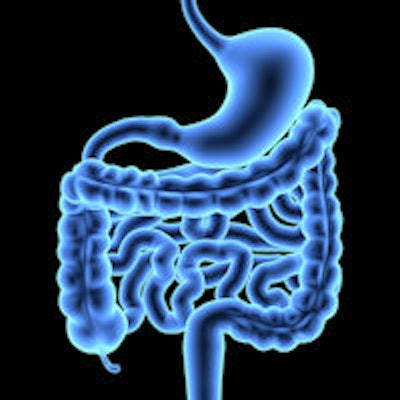
In the first randomized trial to pit CT colonography (CTC) against the fecal immunochemical test (FIT) and conventional optical colonoscopy, FIT yielded a higher participation rate than CTC but found fewer cancers and advanced lesions, according to results published in the Journal of the National Cancer Institute.
Meanwhile, reduced-prep CTC attracted more participants than full-prep CTC, without a significant difference in detection sensitivity between the two -- and both forms of CTC yielded more participants than optical colonoscopy, said investigators from the University of Florence in Italy. CTC detected more cancers and advanced adenomas per participant and per trial invitee, wrote lead author Dr. Lapo Sali, PhD, and colleagues (JNCI, December 30, 2015).
 Dr. Lapo Sali, PhD, from the University of Florence.
Dr. Lapo Sali, PhD, from the University of Florence."Our study confirmed the high detection rate of screening CTC for cancer and advanced adenoma, which was threefold greater than that of one FIT round and was not statistically significantly different from that of colonoscopy," Sali wrote in an email to AuntMinnie.com. "These data support the potential of CTC for population screening of colorectal cancer."
Notably, almost one-third of the people invited to undergo the exam responded, despite a general lack of knowledge about CTC, he added. Sali is an assistant professor of experimental and clinical biomedical science at the University of Florence.
Which test when?
Knowledge is limited about how well the tests stack up against each other.
"To date, no randomized controlled trial has compared CTC and FIT for population screening of [colorectal cancer]," the authors wrote.
The Screening for Colorectal Cancer with FOBT, Virtual Colonoscopy, and Optical Colonoscopy trial, or SAVE, aimed to compare participation rates for reduced-prep CTC (r-CTC) and full cathartic prep CTC (f-CTC). The trial included data from more than 16,000 subjects at a single center in Florence, Italy.
Residents ages 54 to 65 years were invited by mail to undergo one of four screening interventions: biennial FIT for three rounds, reduced-prep CTC, full-prep CTC, or optical colonoscopy. Participation rates and detection rates for cancer and advanced adenomas were compared as primary outcome measures.
The current paper is limited to the first screening round; findings at subsequent rounds and a cost analysis will be reported separately, the team wrote.
Protocols
For the CTC exams, reduced preparation included administration of 13.8 g of diluted macrogol 3350 (Norgine). Full cathartic preparation consisted of 2 L of polyethylene glycol followed by 2 L of clear liquid over two days. Iodinated oral contrast was used for tagging. Colonic distention was performed with an automatic carbon dioxide insufflator (ProtoCO2l, Bracco Diagnostics) after administration of an antispasmodic.
CTC scans were acquired on 64- or 128-detector-row scanners (Siemens Healthcare) using a low-dose protocol of 120 kVp and 50 effective mAs, with a total effective dose of 3.4 mSv to 4.2 mSv per exam.
All CTC scans were read by one of two experienced radiologists, as well as computer-aided detection (CAD Colon, im3D) as the first reader. The readers reported relevant extracolonic findings.
"For the first time, we used CAD as a first reader for screening CTC," Sali said. "We feel that the huge workload of population screening with CTC could benefit greatly from a first-reader CAD, as it reduces reading time and radiologists' fatigue."
Optical colonoscopies were all reported by a single experienced endoscopist. Patients were sedated unless they refused.
FIT was performed using OC-Sensor Micro (Eiken), with a positivity threshold of 100 ng/mL.
FIT participation highest
Participation rates among the 16,087 randomly assigned subjects were highest for FIT and lowest for colonoscopy. Meanwhile, advanced adenoma detection rates were highest for colonoscopy and lowest for FIT, the researchers reported.
| 1st-round results: Participation and detection rates | ||
| Test | Participation rate | Detection rate for advanced neoplasia |
| FIT | 50.4% | 1.7% (79/4,677) |
| r-CTC | 28.1% | 5.5% (37/674) |
| f-CTC | 25.2% | 4.9% (30/612) |
| Colonoscopy | 14.8% | 7.2% (11/153) |
The difference in participation between full- and reduced-prep CTC was statistically significant for all tests (p = 0.047 for r-CTC versus f-CTC; p < 0.001 for the rest).
The differences in detection rate between the two CTC groups and FIT were statistically significant (p < 0.001). However, the differences in detection rate between r-CTC and f-CTC were not statistically significant (p = 0.65). Moreover, the lack of significant differences in detection rate between r-CTC and f-CTC applied both to advanced adenomas 10 mm or larger (3% versus 2.3% for f-CTC) and for all advanced adenomas (5.2% versus 4.1% for f-CTC).
The detection of advanced neoplasia at CTC, comparable to previous studies, was three times higher than that of first-round FIT, according to the authors.
"These data suggest that reduced-preparation CTC is not associated with decreased sensitivity for 6- to 9-mm adenomas with respect to full-preparation CTC," they wrote. The lack of difference is already known for large adenomas, they added.
The authors attributed CTC's performance to a fivefold increase in detection rate for advanced adenomas 6 mm to 9 mm in diameter, for which the poor sensitivity of FIT is well-known. CTC-detected adenomas were also located differently than FIT-detected lesions.
FIT's lower yield in proximal colon
"Interestingly, advanced adenomas detected by FIT were prevalently located in the distal colon, which is in line with previous studies, whereas more than half of those detected by CTC were located in the proximal colon," Sali and colleagues wrote. "These findings may suggest a different sensitivity of the compared tests for proximal and distal advanced adenomas, but further investigations are needed."
Although FIT remains the test with the greatest screening participation, reduced cathartic preparation increases the participation rate of CTC screening for colorectal cancer, the authors concluded.
"Our study finally verified the hypothesis that a reduced preparation increases participation for screening CTC," Sali said. "Combining this information with the fact that reduced-prep CTC had the same detection rate of full-prep CTC, we can assert that screening CTC should be performed with a reduced preparation."
Public information campaigns are still needed to combat the lack of knowledge about CTC, he added.
The 14.8% participation rate for optical colonoscopy was only about half that of CTC, lower than the group expected but in line with other trials, Sali noted. "We feel that colonoscopy is still perceived as an invasive and burdensome examination," he said.
CTC's lower participation rate and higher detection rate versus FIT are key factors to consider in optimizing its use in screening, the authors wrote.
The results of subsequent rounds will likely improve the detection rate of FIT, which has a cumulative sensitivity. Cost analysis will place three rounds of FIT against one round of CTC. Issues surrounding CTC that still need evaluation include cost-effectiveness, management of extracolonic findings, and screening intervals, according to Sali.
"CTC is a solid performer in detecting significant colorectal lesions," he said. "Participation in screening CTC is promising -- yet still inferior to FIT. FIT remains a valuable screening test because it is cheap, easy to do, and well-accepted by screenees. Importantly, it is demonstrated to reduce mortality for colorectal cancer in randomized trials."
In an accompanying editorial, Dr. Ernst Kuipers, PhD, and Dr. Manon Spaander, PhD, from Erasmus University Medical Center in Rotterdam, the Netherlands, wrote that because screening methods are so different, one test cannot be said to be superior to another, but follow-up is important for all screening tests. The finding that reduced-prep CTC increases the participation rate compared to full-prep CTC is important, they added.



















